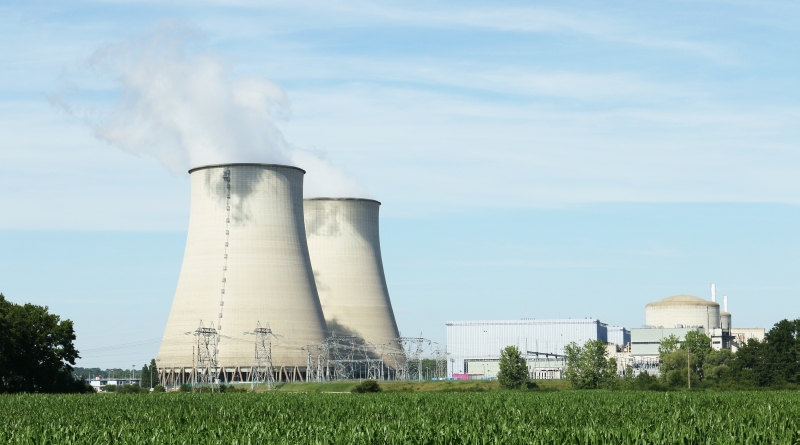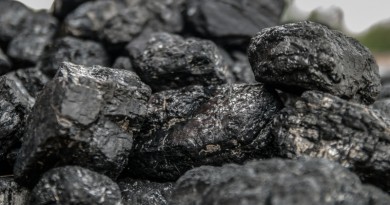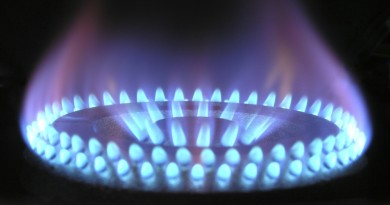Nuclear energy
Contents
Almost two billions of people across the globe don’t have access to electrical energy and this problem will become even worse since Earth’s population is growing. Global relying on fossil fuels and huge hydro-electrics will remain trend at least to year 2020, but that won’t be enough to satisfy constant and ever-growing humanity needs. As one of the possible solutions of this problem, nuclear energy isolates itself. In the last three decades nuclear energy has significant part in electrical energy production. Momentarily with the help of the nuclear energy, 16% of total world’s electrical energy production is generated. Strong burst of nuclear energy can be related with its purity and almost non greenhouse gases’ emission. Well constructed nuclear power plants showed to be reliable, safe, economically acceptable and ecologically benign. Till this date more than 9000 reactor-year work was accumulated, so necessary experience in using the nuclear energy was also summoned.
ENVIRONMENT INFLUENCE AND RADIOACTIVE WASTE
Like every other process of energy production from non renewable sources, nuclear power plants are producing waste as well, in this case radioactive waste and hot water. Since nuclear power plants are not producing the carbon dioxide, its use isn’t increasing greenhouse effect. Radioactive waste is generally divided in to a two main categories: low-radioactive and high-radioactive waste. Majority of nuclear waste is low-radioactive waste. Those are usually: junk, equipments, protective suits and others. That waste is contaminated with small level of radioactive dust or particles, and must be safely kept in order not to get in contact with outside materials.
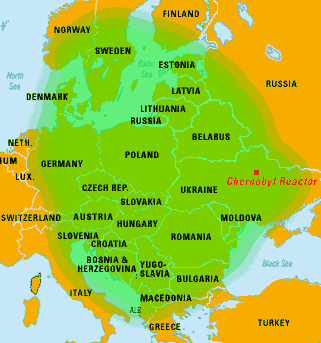
Real problem concerning the nuclear power plants is remain of the used fuel which is high-radioactive waste and must be stored in special pools (water freezes nuclear fuels acting as radiation shield) or in dry containers. Older, less radioactive fuel is stored in dry warehouses where is sealed in special containers made of a ferro concrete.
Nuclear power plants, despite being harmless for environment if everything is played by the rules, still present great threat to environment in possibility of nuclear disaster during irregular use. Two major nuclear disasters happened during the peacetime: Chernobyl and Island Three Miles. The biggest disaster that ever happened in nuclear power plants was in Chernobyl, former SSSR, now Ukraine, on 26th April of 1986. Reactor number four exploded in power plant forming radioactive cloud which spread to a big part of Europe (picture). 27% of rescuers that went to a contaminated area became invalids and 200.000 of them went inside. During explosion, reactor’s active zone was devastated, with 10 days and 10 nights lasting active level of disaster, accompanied with intensive release of radioactive elements. Radioactive elements’ release was finally stopped after reactor had been stored in to a concrete “sarcophagus” in November of 1986. Total radioactivity under the “sarcophagus” surpasses two millions Curie.
Less damaging disaster for people and environment was the on Island Three Miles on 28th March of 1979 in Pennsylvania. There, because of the series of mistakes and security failures, one of the nuclear reactors overheated and partly dissolved, which resulted with smaller emission of radioactive substances in to an atmosphere. For time being, no harmful consequences of that radiation were noticed on the people, but that event had great influence to conception of nuclear energy safety. In days that followed, there was large interest of media for this accident and nuclear energy demonstrators have finally gotten good reason for huge anti-nuclear campaign in the media. That campaign got its additional side effect in media because of the movie “China Syndrome” which started showing in cinemas just couple of weeks before the Island Three Miles’ accident. In that movie, because of the series of safety failures nuclear reactor was almost dissolved, so even today nuclear reactor’s melting is colloquially called “China Syndrome”. All those happenings have not only convinced US government to increase nuclear installments’ safety, but also to decrease the number of newly build nuclear power plants.
WORKING PRINCIPLE
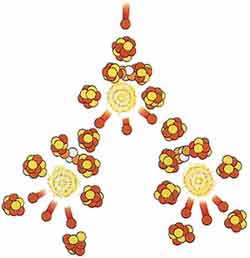
Nuclear power plants are using as a fuel isotope of uranium U-235 which is very suitable for fission. In nature can be found uranium with more than 99% U-238 and only about 0.7% U-235. While U-238 is absorbing fast neutrons, U-235 on the other hand, when bombarded with slow neutrons degrades itself to very radioactive products of fission, releasing in this process more fast neutrons (process). Deceleration of these fast neutrons when crashing with molecules of heavy water, which is heating itself in process, makes the nuclear chain reaction possible. Released heat is in fact this desirable energy. In nuclear reactors this process happens all the time in strictly controlled conditions (couple of moments in Chernobyl excluded). Atomic bomb is the result of deliberately caused enormous concentration of free neutrons which are then crashing with fission’s sensible atoms achieving uncontrolled energy explosion in the process. Although there’s a significant number of Uranium in nature (hundred times more than silver) U-235 isotopes is very rare. Because of that uranium enrichment procedure becomes necessary. In final, useable faze, nuclear fuel will have a form of two and the half centimeter’s long tablets. One this tablet will be enough to give approximately same amount of energy as one ton of coal. Energy released when bombarding uranium with neutrons is used for the water heating. That water (steam) is then starting generator, and after that it’s necessary to cool the water off and put it back to a reactor. To succeed in this, it’s necessary to maintain constant and big fluidity of the water around the core of the reactor.
COUNTRIES’ USE OF NUCLEAR ENERGY
Country that has the largest share of its electrical energy manufactured in nuclear power plants is France with 75%. Lithuania follows with 73%, and then Belgium with 58%, Bulgaria, Slovakia and Sweden with 47%, Ukraine with 44%, and Republic of Korea with 43%. Ten countries more have more than 25% of its total electrical energy produced in nuclear power plants. US is producing 19.8% of its electrical energy in nuclear power plants, but because of the high production range they are having the biggest share in the total electrical energy produced in nuclear power plants with 28%. France is second with 18%, and Japan third with 12%.
With the rising number of countries having nuclear power plants, risk that fuel from nuclear power plants will get in the hands of individuals that won’t use it for peaceful intentions increased as well. Lately terrorism is being very alluring and terrorists with nuclear technology in their dispose could cause huge nuclear disaster. Politicians and scientists must take certain measures to protect us from this malicious use of nuclear energy. International organizations, specifically because of this problem imposed the safety rules for 140 countries across the globe. Problems with storage of the nuclear fuel (and radioactive waste as well) is momentarily mostly expressed in poor countries, former members of SSSR.
Additional atricle: How does nuclear power plant work?
More to read: Nuclear technology
